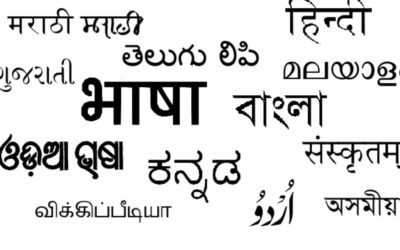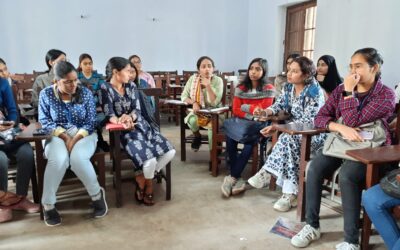The Pindwara district in the state of Rajasthan is known for its mining industry. Every year, almost thousands of men from this region, either migrate to cities or are posted at sites within Pindwara for stone grinding activities. The work usually involves building temples and carving intricate designs within their walls using Rajasthan’s famous stones, including soapstone, sandstone and red stone.
“About 10 years ago, the men who worked in this sector were respected and people would want to marry their daughters into these families, knowing that she would be taken care of with the lucrative income from the groom’s end.” remarked Bharmaram, a health worker at Amrit Clinic. “Today, it is just the opposite, there is no respect for this line of work, everybody knows it brings death.”
Silicosis is an irreversible lung disease caused by inhalation of dust that contains free crystalline silica. When workers cut, crush, drill, polish, saw, or grind products that contain silica, dust particles are generated that are small enough to lodge deep in the lungs and cause long-term respiratory diseases including silicosis. With its potential to cause progressive and permanent physical disability, silicosis continues to be one of the most important occupational health illnesses in the world with no cure.[1]
21-year-old Noka Ram* from a village called Sai Dam in the Kotda tehsil of Rajasthan was diagnosed with silicosis in the month of August 2022.
Noka Ram was advised by his older brother to work at a mining company. His elder brother passed away in 2018 after contracting silicosis and failing to receive the required treatment. Their father had lost his arms and had barely any eyesight left after a fishing accident, leaving the three sons to support the family. When Noka’s health started to decline the same year, he was first rushed to a private hospital in Pindwara. He was referred to another hospital where he had to pay Rs. 30,000 for a simple procedure of removing pus from the back that is filled inside the lungs. The hospital refused to take responsibility for further treatment and instructed the family to take Noka to a tertiary hospital in Udaipur. He was admitted there for about a month and a half while his expenses exceeded a lakh. He is still paying this debt off.
I asked Noka, “Why did you go back to work?” Noka shared that he felt a lot better after the care received at the tertiary hospital. The money spent on his as well as his deceased brother’s treatment, needed to be paid off. The family land and jewelry were mortgaged in order to afford medical services. He humbly replied,
“After spending 2 years in training and 3 years working, I cannot do anything else. I get tired very easily. I cannot physically pick myself up to do anything other than grind a stone with the machine at one place. Besides, what options do I have? I am not educated, and I can barely move. Who will hire me? I need to pay off the debt.”
Fortunately, the third brother chose to go the other way and work at construction sites to make ends meet. He is healthy and looking after his only brother, with the hope that he recovers.
Similarly, Anda Ram* was brought to Amrit Clinic with great difficulty. His fatigue wouldn’t let him stand for too long. He spent almost 10 years in the stone carving industry. After starting medication from Amrit Clinic in February this year, he is much better now, with no intention to work there again.
A total of 328 silicosis patients have received care from Amrit Clinics this year. “Amrit Clinics provide every silicosis patient with medications and detailed counselling. When a new patient is linked to the clinic, I personally visit their home within fifteen days to support the patient and the family. Minimum three visits are mandatory, once a month for three months. This has helped patients sustain their hope and start feeling better.” shared Bharmaram, the health worker supporting and leading silicosis patients in villages around Rawach village based Amrit Clinic.
Villages named Ranidhara, Bhagdhaari, Kundaal, Dhapavaas, Phulwai Kheda, and others are known as the ‘House of Death’ or the ‘Village of Widows’. These villages have an alarming number of mothers left to feed and raise their children all by themselves. Aajeevika Bureau has been doing prominent work to ensure that labourers are aware of their rights, especially those risking their lives for mining activities.
Compensation By The Government
The government is supposed to provide Rs. 300,000 as one-time assistance to the affected person after certification. In the event of the death of the Silicosis victim, the nominee or legal heir will receive Rs. 200,000. In 2019, the state government approved Rs 1,500 per month as pension for a silicosis patient.
There is a widow pension to the wife and benefits under Mukhyamantri Palanhar scheme. On the death of the pneumoconiosis patient, the government also provides funeral assistance of Rs. 10,000 to the dependent. The certification makes the patients eligible for several social welfare schemes run by state and central governments. However, a loophole seems to keep silicosis patients from receiving the certification in the first place. Failure to detect silicosis does not constitute an offence under the statute.[2]
While those detected with silicosis receive their compensations after tedious attempts to register, there are many who don’t. “I have been told to come back when my lungs are much worse. They said that I don’t have enough Silicosis present and I should work some more to receive the relief package.” shared Hakma BagaRam*. This isn’t the only instance where the X-rays of patients with silicosis have been rejected even after a clear indication of its presence.
The law requires doctors to notify each and every case of detected silicosis to government, however, there seems to be resistance to this process. The penalty for not reporting the disease is a mere Rs. 50. Lack of training around the guidelines set by the International Labour Organization (ILO) to help doctors identify abnormalities from occupational lung diseases in chest X-Rays, stands in the way of rightful certification. “It is not clear on what basis they reject a suspected case of silicosis/asbestosis.” shared the Rajasthan State Human Rights Commission.[3]
Protection At The Site
For a brief amount of time, the workers would tie a cloth around their faces to avoid inhaling the dust particles. The cloth does little to nothing to stop the specks from entering the lungs. The majority of the time, they work without any gloves and with no mask at all. There is no signboard to mention the hazardous activity happening at the site and many times, the workers’ children are also seen playing around.
Countries like Australia, Belgium, Canada, Finland, France, Germany have successfully established that it is possible to significantly reduce the incidence of silicosis with well-organized prevention programs. The absence of a cure for this life-threatening disease leaves us with only one option – to reduce the exposure of silica-containing dust particles at mining sites.[1]

To Choose Is A Privilege
Who is responsible for the deaths? If you ask the employer or even the worker, they will simply say that men sign up with the choice of their own to do the work. Nobody forces them. I say, what other options do they have, when they are coerced and limited to stick to one profession for a variety of reasons, a major one pertaining to the constant decline of health.
The Government has its schemes in place, so what is the problem? We are quite accustomed to the delay and the laid-back response to any government intervention in India, isn’t this just one of them? When will we realize that the life of a daily wage worker will never have a monetary limit, because he is human too and deserves to live a dignified life?
It is almost so ironic that men from remote hamlets are lured into the trap of building sculptures and temples for Gods, nationally and internationally. The selling argument being, ‘Yeh toh Bhagwan ka kaam hai, bhagwaan aapko dua dega.’ (This is God’s work; he will bless you)
[1] Occupational Health: Silicosis (ILO), Crystalline silica and silicosis | Safe Work Australia
[2] National Programme on Elimination of Silicosis in India :The Lessons Learnt




0 Comments